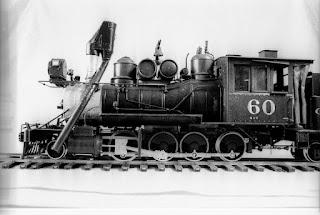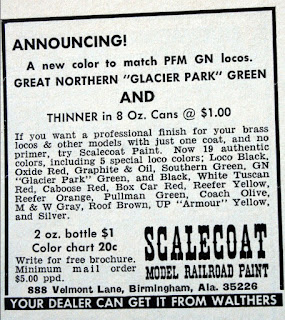 |
| Kemtron HOn3 brass kit of the D&R G C-16 |
Fortunately, I have a few photo examples of my early "training." Among the photos I found both 35mm and medium format negatives of the Kemtron C-16 I mentioned in part 3. I built this kit over 40 years ago after I got out of the Navy. I also found I had photos that I didn't remember taking. Somewhere along the way the Model Die Cast narrow gauge engine I sold to the modular group I was a part of happened to pass before my Mamya 645.
 |
| Model Die Cast HOn3 outside frame (C-21?) |
I don't know exactly when MDC first offered the powered narrow gauge 2-8-0s - about 1974 I believe - but I purchased this outside frame kit perhaps prior to the C-16. It was an intriguing project I probably bought when I became involved with Slim Rail. I didn't have a module of my own but I wanted something to run during our shows.
Building the model was fun and straight forward and, as you can see, the C&Sng was already a strong influence upon my efforts. I gave it my own paint scheme and fictional road name. The model was airbrushed black, silver and the masked off areas were a light sea green (Humbrol). The herald was inspired by a layout idea that I began a year or two later. I briefly described that pike in part 3 along with the white metal Keystone Shay kit. Unfortunately I didn't take any photos of either the shay or the layout. I sold the Connie to the modular group when I went to school in Denver
I've been a photo enthusiast for nearly as long as I've been a railroad modeler. I started with a Canon SLR when I joined the Service and eventually became the ships photographer while over seas. I've taken many pictures as record and many of models that help when telling this story. |
| Kettle Creek is located in Black Forest, CO. |
The C-16 was my first brass kit. My cheap soldering iron probably came from Radio Shack and may have been as much a hindrance as it was successful but I had learned how to solder at a pretty young age; that surely helped me get thru this project. Somewhere I purchased a tube of solder paste with flux already in it - what a novel idea! It took me a while to put it together but it turns out soldering brass takes a long time anyway. It isn't the actual soldering but the preparation and jigging that takes time. I enjoyed the "doing" and was pleased with the results. I don't recall how it ran - probably not well - but that didn't discourage me.
 |
| D&RG C-16 with a kit-built DSP&P Waycar |
The waycar shown with the C-16 was from a kit, probably E.& B. Valley and clearly not a very accurate example of the D.S.P.& P. prototype. I don't remember when I built it as the photos were taken some time after I sold the Canon F-1 and purchased the Mamya (1981).
Half or more of the success of any task seems to rest on a certain confidence that you know you will figure out any issues that arise. In other words, you don't lose if you don't quit. When I finished the C-16 I built Kemtron's D.& R. G. 0-6-0t with the intent of converting it to a C & S mogul. That didn't happen.
As I described previously I became frustrated with the smallness of narrow gauge in HO scale. I finally traded or sold off the HO stuff to purchase (as I now recall ) an O scale Denver South Park & Pacific mogul imported by Balboa. I scratch built several D.S.P. & P. freight cars to go with it. |
| I scratch built this On3 Tiffany "freezer"... |
I did find a kit for the waycar offered by Don Winters but even that could be described as scratch building out of a box. The instruction sheet provided an elevation drawing perhaps a brief description and
 |
| ... as were all of the cars in this view |
these suggestions; "get a six pack of beer, look at the drawing and published photos and put the kit together." Except for the beer (which didn't seem like a good idea for this method of construction) that is what I did. It turned out to be a fun project.
 |
| Don Winters On3 waycar; post 1911 numbering |
However, there came a point where I decided I still wasn't working in a direction I wanted to go. The "South Park," while fascinating in history, still didn't have the attraction its grandchild, the Colorado & Southern RY. had. I took the Mogul back to Caboose and traded it and several freight cars for an Iron Horse Models, On3, C&S, No. 60 2-8-0 kit. This was the most serious brass project I had gotten into up to that point. There were hundreds if not thousands of
 |
| I also added the detailed interior |
parts in the box and the kit took many evenings to complete. If I recall, I put it together more than once because I made many mistakes.
Perhaps the greatest importance of the Iron Horse kit was how much it taught me. When I finally got it put together and painted, it looked a lot like the model below that I obtained several years later. I painted and numbered the kit as C&S 62.
I was fascinated with the orphaned (once D.S.P.& P.
mainline to Gunnison ) branch known as the Buena Vista Romley division. I later understood more about
 |
| PSC On3 No. 60 was painted when I got it |
how no. 62 - and all of the Rhode Island connies - were unique from each other. I re-worked the model yet again.
The photo below provides a good reference of the 62 at Buena Vista in 1925. The photo was loaned to me by its creator, Richard Kindig, with permission to make a copy negative. This was the sole motive power for that branch in the final days of that portion of the railroad.
 |
| C&S 62 at Buena Vista in 1925 |
Next time I'll show you what the model of 62 looked like on a later layout.
















